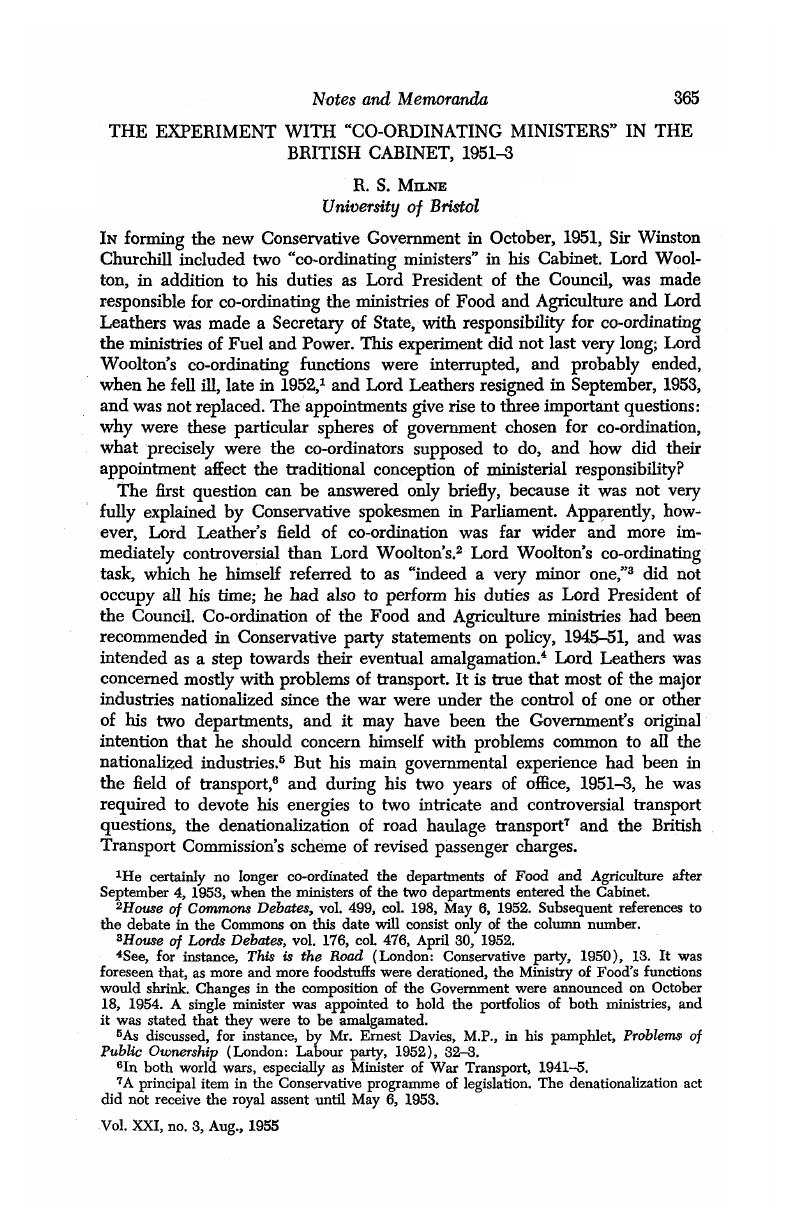No CrossRef data available.
Article contents
The Experiment with “Co-ordinating Ministers” in the British Cabinet, 1951–3
Published online by Cambridge University Press: 07 November 2014
Abstract

- Type
- Brief Report
- Information
- Canadian Journal of Economics and Political Science/Revue canadienne de economiques et science politique , Volume 21 , Issue 3 , August 1955 , pp. 365 - 369
- Copyright
- Copyright © Canadian Political Science Association 1955
References
1 He certainly no longer co-ordinated the departments of Food and Agriculture after September 4, 1953, when the ministers of the two departments entered the Cabinet.
2 House of Commons Debates, vol. 499, col. 198, 05 6, 1952.Google Scholar Subsequent references to the debate in the Commons on this date will consist only of the column number.
4 House of Lords Debates, vol. 176, col. 476, 04 30, 1952.Google Scholar
4 See, for instance, This is the Road (London: Conservative party, 1950), 13.Google Scholar It was foreseen that, as more and more foodstuffs were derationed, the Ministry of Food's functions would shrink. Changes in the composition of the Government were announced on October 18, 1954. A single minister was appointed to hold the portfolios of both ministries, and it was stated that they were to be amalgamated.
5 As discussed, for instance, by Mr.Davies, Ernest M.P., in his pamphlet, Problems of Public Ownership (London: Labour party, 1952), 32–3.Google Scholar
6 In both world wars, especially as Minister of War Transport, 1941–5.
7 A principal item in the Conservative programme of legislation. The denationalization act did not receive the royal assent until May 6, 1953.
8 H. of L. Debates, vol. 176, col. 475, 04 30, 1952.Google Scholar
9 Col. 192.
10 H. of L. Debates, vol. 176, col. 525, 05 1, 1952.Google Scholar
11 H. of C. Debates, vol. 500, col. 1117, 05 13, 1952.Google Scholar
12 Col. 194. In his Government and Parliament (Oxford, 1954)Google Scholar, Mr. Herbert Morrison seeks to distinguish “co-ordinating ministers” from “supervising ministers” (45 et seq.).
13 The ministers of Food, Agriculture, Transport, Fuel and Power.
14 H. of L. Debates, vol. 176, col. 635, 05 6, 1952.Google Scholar
15 Ibid., vol. 176, col. 633, May 6, 1952.
16 The system of Cabinet committees was apparently not materially changed by the appointment of co-ordinating ministers ( Mr.Butler, R. A., H. of C. Debates, vol. 494, cols. 426–7, 11 21, 1951 Google Scholar), although Lord Woolton disclosed that he himself had taken the place of one committee ( H. of L. Debates, vol. 176, col. 476, 04 30, 1952 Google Scholar).
17 See below, on Cabinet committees.
18 Col. 193.
19 It is noteworthy that Opposition spokesmen suggested that Lord Leathers and Mr. Maclay (the Minister of Transport) did not agree on the suspension of increases in transport fares early in 1952, and that Lord Leathers' point of view prevailed (The Times, May 6, 1952). Mr. Maclay resigned early in 1952 for reasons of health.
20 H. of C. Debates, vol. 229, col. 873, 07 10, 1929.Google Scholar
21 Ibid., vol. 239, cols. 2355–6, June 5, 1930; vol. 240, cols. 1136–9, June 25, 1930; vol. 240, cols. 1952–3, July 2, 1930). Also Snowden, Viscount, An Autobiography (London, 1934), 775, 880–1.Google Scholar
22 See Mr.Amery's, Thoughts on the Constitution (Oxford, 1947), 90 ff.Google Scholar; also Chester's, D. N. chapter on the Cabinet in British Government since 1918 (London, 1950).Google Scholar
23 The Minister of Fuel and Power had been in it from 1945 to 1947.
24 The Conservative Cabinet actually contained 16 ministers, compared with 17 in the previous Labour Cabinet. Its numbers have subsequently fluctuated between 17 and 19.
25 H. of C. Debates, vol. 368, cols. 257–9, 01 22, 1941.Google Scholar
26 Both amalgamations came into effect in autumn, 1953.
27 “The Machinery of Government,” Political Quarterly, XIX, no. 1, 1.Google Scholar
28 See the author's “The Junior Minister,” Journal of Politics, XII, 1950, 437.Google Scholar
29 SirHorne, Robert, H. of C. Debates, vol. 132, col. 1805, 07 29, 1920.Google Scholar




